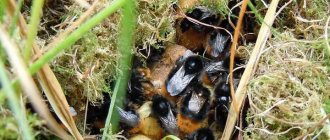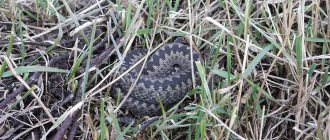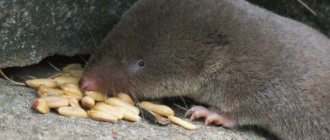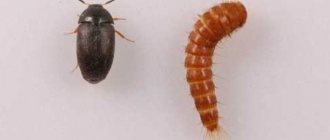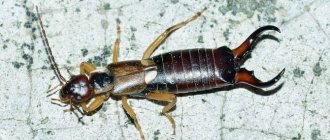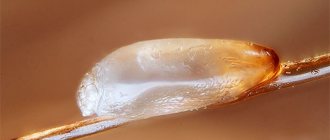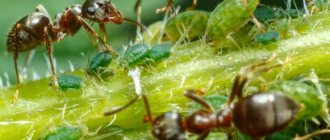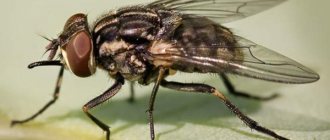Kinds
The most common species in our latitudes are:
| Name | Description | Habitats | Nutrition |
| Common wasp | The most common type. The length of the body is up to 2 cm. They are most common in temperate climates. It differs from other species in its large size and black tip of the body. | Nests are built in rodent burrows, deep in bushes, in the dense crown of a tree, under the roof of a barn, between walls, etc. They can form large colonies - up to 5 thousand worker wasps and about 10-12 thousand larvae. | In April-May they feed on nectar, and by mid-summer - on ripe fruits and berries. |
| French (Gallic) | A small insect with a thin body. Similar in color and size to a paper wasp | It is found in zones with a middle climate, but most of all they can be found in the southern regions. Nests can be found under the roofs of outbuildings and residential buildings, in dense bushes. | Eats ripe and rotten fruits. The larvae are fed on caterpillars, bees, and the larvae of other insects. |
| German wasp | Outwardly it is similar to an ordinary wasp, but has a much smaller body - 1.2-1.5 cm. The tip of the abdomen is yellow. | The species can be found in the wild, in rural areas and even in large cities. The swarm most often builds a nest underground, on the loose edge of a cliff, in abandoned burrows. In the city, nests can be built in attics, in wall voids or under a layer of thermal insulation. Sometimes they can be found in vacant lots or parks. | Wasps found in rural areas feed on nectar or small insects. In cities, these insects feed on food waste in landfills, markets, and garbage containers. |
| European paper wasp | The individuals are small in size, have a thin abdomen, and are predominantly black in color. The species reproduces quickly - in one season the number of a swarm can increase tens of times. | They settle under the roofs of houses, on the stems of bushes, in juniper thickets, and on thuja. Honeycombs are built by chewing old wood. | Adults feed on nectar, juice from fallen fruits, and aphid secretions. The larvae are fed insects. |
| Hornet | One of the largest wasps found in our latitudes. The body reaches 2.5-3.5 cm in length. | Found in temperate regions, it avoids the coldest and hottest areas. Hornet nests are shaped like wasp nests and are brown in color. Nests are built in abandoned alien hives, burrows, and on tree branches. | They feed on fruits and berries, secretions of aphids, and confectionery. The larvae are fed small insects until the end of summer, and bees in the fall. |
At the end of spring, when there are no ripe fruits yet, the wasps' diet mainly consists of small insects and flies. For food, they can steal prey from ants and spiders.
Why and features of wasps appear
Why do wasps appear in the country? There is no clear answer to this question. They appeared and appeared! But why is a topic for a separate scientific conversation. Some summer residents themselves specifically attract wasps, knowing that they can destroy many pests. At the same time, they risk their health, although everything is quite relative. If wasps are not provoked, they are unlikely to attack a person. Unfortunately, not everyone is so prudent, especially children who are interested in everything. Therefore, they may be the first to suffer. In addition, housewives are terrified of wasps, which is why they have to make a decision to destroy them. By the way, it should be noted that in nature there are many varieties of wasps, which differ in both color and size. In addition, there are wasps that live in colonies (social wasps), and there are solitary wasps that prefer a solitary way of life.
Adult wasps feed on the nectar of flowers, the juice of vegetables and fruits, as well as berries. At the same time, they do not fly past meat or fish. Wasp larvae prefer small insects, including spiders. Different types of wasps reproduce in different ways. In wasp colonies, the queen is responsible for reproduction. At the same time, the male fertilizes her once in her life, after which she provides the colony with young wasps throughout her life. Those that have chosen a solitary lifestyle select moments for mating, after which they lay eggs.
Why wasps settle in dachas, near people, is an interesting question, although there are a sufficient number of versions. For example:
- They return to their former nesting sites. First of all, scout wasps appear, checking for comfortable conditions, after which the entire colony appears.
- Availability of food for existence. Wasps settle in places where they can access food: near flower beds or fruit plants.
- Near colonies of pests that the larvae prefer to feed on. Adult wasps make sure that the larvae do not have problems with food.
It is not easy to determine that wasps have settled on a summer cottage. Some summer residents do not even suspect this. Or maybe this is correct, since no one bothers them and they do not show aggression. Unfortunately, some summer residents do not like the fact that wasps are constantly flying around the territory. They interfere with eating normally, especially if there is a fear that a wasp might bite. In this case, you will have to track where the wasps are flying and then begin to destroy them. To do this, you need to prepare a tasty bait and place it in a visible place. The wasps will immediately fly off, and after eating they will head to their nest. If you are careful, the nest is not difficult to find.
Benefits and harms
In summer, wasps are useful for the site - in order to feed the larvae and the queen, they hunt ants, mole crickets, chafers, caterpillars and other small insects. One individual can destroy 30-40 insects per day.
Wasps also take part in the pollination of flowers - just like bees, they, feeding on nectar, transfer pollen from one plant to another on their legs and abdomen.
There are more negative aspects of being close to wasps:
- Harvest damage . Wasps love to eat juicy sweet fruits and berries - apples, pears, grapes, raspberries, plums, cherries. If in large fruits they leave bite holes, then in small berries they can simply bite through the peel and suck out the soft, sweet pulp.
- Destruction of bees . In autumn, wasps can cause great harm to the apiary - at this time there are few insects left in the natural environment and, in order to feed the larvae, striped hunters eat bees.
- Intestinal infections . Some species of wasps are attracted to human food, which they may search for first in a landfill and then on someone's dinner table. Insects can carry many dangerous infections on their legs, so any food or drink in which a wasp has been must be thrown away.
- Bites . Wasps themselves are not aggressive, but if you approach their nest, they will attack the attacker. The poison is quite toxic and can cause a serious allergic reaction in some people.
Procedure for expulsion
It is advisable to begin fighting wasps in early spring. During the fall, most of the workers die and you need to have time to destroy the hive before they have time to breed new offspring. Most often, females build nests alone, during the summer they hatch several offspring and the swarm increases tens of times.
In spring, the nest may contain one or more females and larvae. It is best to destroy the nest in the dark - even if there are working individuals in the nest, their activity decreases in the dark.
The best time to deal with wasps is in the late evening, when it gets dark. By this time, the workers return to the nest and their activity decreases.
Before destroying a nest, it is important to dress properly - put on the tightest clothing possible, through which it is impossible to get stung. Be sure to wear canvas gloves on your hands, a thick hat and a mosquito net on your head. It is important that all areas of the body are covered as much as possible, if a jacket has a hood, if trousers and a jacket have elastic cuffs, so that insects cannot penetrate under the clothes.
The nest can be knocked down with a stick or any object with a long handle and it is advisable to burn it so that new insects do not move into it. If the wasps lived in the ground or a hollow tree, the area must be thoroughly treated with an insecticide.
Before you start fighting wasps, you need to stock up on antihistamines (for example, suprastin), which will help reduce the allergic reaction in case of a bite.
In the period from late spring until autumn, it is better not to touch the nests - this way you can turn a whole swarm against yourself. It is much safer to destroy insects at a distance from the hive. There are many ways to do this.
Insecticides
Unlike other insects, an attack by a wasp or hornet can cause the death of a person from Quincke's edema or anaphylactic shock. Therefore, in specialized stores, means for their destruction are presented in a wide range. Domestic and foreign manufacturers produce them in the form of aerosols, sprays, ready-made solutions, and powders for preparing dilutions. The most popular are Mosquitall, Delta Zone, Executioner, and Tetrix.
How to choose the best insecticide:
- High-quality chemicals destroy wasps at any stage of development. They do an excellent job with the uterus, sexually mature workers, and faces. This distinguishes them from folk remedies, which often only repel insects.
- If the wasp nest is compact, then you should buy insecticides with quick action. Sprays and ready-made solutions will do the job well. It is often not possible to accurately determine the location of the nest. In such cases, long-acting chemicals are effective. A poisoned but still living wasp will infect the entire population of the nest the next time it visits.
For the destruction of single wasps, sweet baits generously moistened with poisonous agents are ideal. The method is effective, but during the “hunt” it is better to remove small children, pets and birds from the room. The Msquitall aerosol against dangerous wasp nests has proven itself to be safe for human health.
It is not advisable to treat a summer cottage during the flowering period. Not only wasps will die, but also beneficial insects (bees, butterflies, dragonflies) that feed on sweet flower pollen and nectar. The best ways to kill bees yourself
"Karbofos"
“Karbofos” not only destroys bees and wasps, but also repels them from the summer cottage and the premises they have chosen with its smell. It is highly undesirable to use it in residential premises due to its high toxicity. The composition of karbofos includes malathion, fillers and fragrances. It is produced in the form of powder in bags, a concentrated suspension in ampoules and a ready-made solution in five-liter containers.
After entering the insect's body, malathion blocks the digestive system. The wasp loses the ability to fully feed and soon dies. But before that, she manages to transmit the poison to other inhabitants of the nest.
Attention! The disadvantages of Karbofos include the gradual resistance (stability) of insects to the action of the poison. Soon, their bodies begin to produce enzymes that make the wasps immune to the insecticide.
"Delta Zone"
"Delta Zone" is intended for double treatment of utility rooms and garden plots against wasps at monthly intervals. The insecticidal effect is based on the poisonous properties of deltamethrin, a chemical substance that is highly safe. You can return to the room treated with this thick and viscous solution after 20–30 minutes.
"Executioner"
The insecticide quickly disappears, leaving no stains or suffocating odor behind. It is effective against almost all harmful insects, including blood-sucking ones. "Executioner" is produced in the form of a concentrated solution, the active ingredient of which is fenthion. After mixing, the dilution is placed in a spray bottle and the areas in the country where wasps are expected to swarm are carefully treated.
"Tetrix"
The active ingredient of the insecticide is metaphos, intended primarily for the destruction of crawling insects. In the fight against wasps, Tetrix is used exclusively for treating a previously discovered nest. Spraying the solution on it leads to massive death of wasps. The insecticide is sold in the form of a concentrate in glass or plastic containers.
"Dichlorvos"
This is a chemical from the group of organophosphorus compounds with a wide spectrum of action. The insecticide is relatively safe for humans, therefore it is actively used to kill wasps even in residential areas. “Dichlorvos” by dehydrochlorinating chlorophos, a substance that instantly paralyzes the insect. The drug has only one drawback - its sharp, repulsive smell lingers in the air for a long time.
"Dichlorvos" must be stored out of the reach of children. Its bottle is similar to a regular air freshener, so if sprayed in a cramped room, there is a high probability of intoxication of the child.
Preparations based on chlorpyrifos
Many manufacturers produce insecticides with chlorpyrifos, since this chemical compound in minimal doses destroys huge nests and colonies of insects, including wasps. It is more stable compared to other organophosphorus compounds and exhibits a pronounced intestinal effect.
Folk remedies for destruction
With the help of folk remedies, you can quickly and easily get rid of unwanted neighbors on your property.
Watermelon rinds
Melon or watermelon rinds would be good bait. It is necessary to water them with an insecticide with a neutral odor and spread them around the area - the insects will feast on the poison and die.
Bottles with bait
It is necessary to cut the plastic bottle into two parts so that you get a separate bottom and a separate top and neck.
Pour diluted jam or syrup into the lower part and insert the top without a lid, neck down. It is important that the bait does not touch the neck of the bottle.
The insect will be able to climb inside, but will not be able to get out and drowns. For greater reliability, the neck can be lubricated with Vaseline or vegetable oil.
Such baits should be placed on the site and hung in the garden. Periodically, dead wasps should be thrown out of bottles and new syrup should be poured into them.
Expert opinion
Mityuk Stefania Bogdanovna
A liquid with a persistent sweet aroma is more attractive to wasps than just sugar diluted with water. Therefore, ideally use old juices, jams or compotes.
Liquid smoke
A harmless way to protect the crop and keep the wasps alive. To do this, you need to spray the bushes and trees with liquid smoke (available at most grocery stores). Insects are afraid of smoke and will not approach fruit plants.
If there is no liquid smoke, instead of it, pine logs can be laid out on the site and set on fire - the smell of burning pine will repel wasps and will not harm people and pets.
Poison cones
To do this, you will need to cut off the bottom of a plastic bottle to form a cone. Near the cut you need to make two holes, with the help of which you can hang the cones on the trees on a rope.
You need to pour diluted jam or syrup into the resulting drinking bowls and add any insecticide against insects.
The wasps will drink the poisoned syrup and die far from the drinking bowl. All that remains to be done is to add new syrup to the drinking bowls.
Can of beer
For this trap you need to use 750-1000 ml glass jars. Place a 1.5 cm layer of sugar on the bottom, add 100 ml of water and add beer to half the can.
Cover with a tin lid with small cross-shaped slits (up to 1 cm in length). The corners of the cuts need to be bent inside the jar - through them the insects will penetrate into the trap and will no longer be able to get out.
Before using the above baits, it is important to ensure that they will not harm bees or pets.
Folk methods of dealing with wasps:
- Dishwashing liquid . Dilute 1/4 cup of product (80-100 ml) in 1 liter of boiling water. Fill the wasp's nest with the resulting mixture and repeat the procedure the next day.
- Smoke from a fire . If the nest is located on an area, for example, on a tree, then you can light a small fire in the grill under the nest. The main thing is not strong fire, but the amount of smoke, because it is this caustic product that destroys wasps. After some of the adult insects have died, the nest itself can be destroyed - for example, by burning it.
- Wasps do not like the smell of fuel . Treat the nest, as well as the surfaces around it, with gasoline, diesel fuel or kerosene. Be careful as this is highly flammable. You should not use this method if the nest is located under the roof or inside the house, in the attic.
- The simplest trap made from a plastic bottle . Cut off the neck of a plastic bottle and turn it upside down. Pour sweet kvass or beer into the bottom of the bottle. Insects (not just wasps) easily get inside based on the smell of the treat, but cannot get out.
How to get rid of wasps in a country house under a roof in an inaccessible place
As a rule, wasps make their nests in a variety of places. They can also be difficult to reach, because wasps move through the air and can easily penetrate cracks under the ceiling, ventilation ducts, etc. In such situations, fighting them becomes significantly more difficult. You definitely won’t be able to use traditional methods; modern methods will help you deal with insects.
Aerosol preparations are an excellent option to get rid of wasps on the roof of a country house. The spraying jet is capable of penetrating the most inaccessible places where adult individuals could fly. One way to combat this is to close access to it when a nest is discovered. The insects remaining in it will soon die of starvation. Those who remain outside will be forced to fly away in search of a more suitable nest.
Polyurethane foam will not help in the fight against wasps, because thanks to the structure of the mouth, insects can easily gnaw through it. We advise you to pay attention to more durable materials, such as fabric or silicone. The fabric should first be moistened with a poisonous material in order to repel pests as much as possible.
Professional products
Destroying wasps with aerosols is dangerous and often impossible - the nest may be in an inaccessible place. The most reliable method is poison traps.
The following ingredients can be added to syrup or diluted jam:
"Karbofos"
Plants are sprayed with this product to kill pests. You can get rid of wasps by adding it to the sweet syrup that fills the bait. Dosage – teaspoon per 200 ml of water.
The drug has many analogues with similar properties:
- "Anti-mite";
- "Fufanon";
- "Alatan";
- "Prophylactic".
"Executioner"
The product acts instantly. Used to kill cockroaches, fleas, ants, bedbugs. To kill wasps, the drug must be diluted, like Karbofos, in syrup (1 tsp per 200 ml of water).
"The Buzzard"
A gel that is used to kill wasps and many other flying pests. It should be applied to strips of plastic or cardboard in small pieces and the cardboards should be placed around the area.
Fixman
This is a wasp trap that is harmless to bees. Insects flock to the smell emanating from the trap - they climb inside and can no longer get out. To activate the bait, you need to add water to it. You can use this trap for 2-4 months.
Traps from other manufacturers work on a similar principle - Rapax, Wasp Trap.
Repeller WT-002
Made in the shape of a wasp's nest. It signals to the wasps that another swarm has already settled in this territory and they need to stay away from someone else's nest.
Repelling wasps in residential areas
Much fewer products are suitable for repelling wasps in residential areas. After all, the method should not only be safe, but also not disturb comfort. For example, you can use:
- pine essential oils for lighting the aroma lamp;
- geranium planted on the windowsill;
- ultrasonic devices;
- small traps with sweet bait.
The most reliable way to prevent wasps from appearing in your home is to cut off their entry routes. Therefore, windows and (if necessary) doors must be protected with mosquito nets, and cracks and crevices in the walls of the house and window frames must be carefully sealed.
Another method to repel wasps is to use special repellents sold in the store. They are produced in the form of sprays for application to the skin and repellents with bright odors. Of all the possible measures to help repel insects, you can choose the most suitable ones.
Recommendations from experienced gardeners
Ivan Mikhailovich, Perm
On the Internet, many people advise pouring kerosene, boiling water or diesel fuel over a wasp’s nest. In fact, not only will this not kill the insects, but it will also make them very angry. Water simply will not bring any effect; kerosene and diesel fuel are not suitable for wasps, but can significantly increase the risk of fire in the area. It is better to use the old proven method and place traps with poisoned jam in the garden. The thicker the bait, the more it attracts wasps.
— Ivan Mikhailovich, Perm
Konstantin, Moscow region
From my own experience I already know that there is no point in sealing a wasp’s nest with polyurethane foam - they will gnaw through it anyway. It is better to poison wasps with insecticides all summer and autumn, and destroy the nest in winter or early spring - at this time there should not be many insects there.
— Konstantin, Moscow region
What means do you use to fight wasps?
FolkProfessional
Irina, Rostov
Under no circumstances try to kill wasps with bleach or dichlorvos. They will not die from bleach and can attack humans themselves. Dichlorvos kills insects, but slowly - for some time after treatment they will randomly rush around the nest and sting everyone who is nearby. If you still need to target the nest and the risk of being stung is minimal, it is better to use the most common domestic dichlorvos with a pungent odor. New varieties with “pleasant aromas” do virtually no harm to insects.
— Irina, Rostov
Mikhail, Ryazan
I'll tell you how you can kill wasps that have built a nest inside the floor or wall. To do this, you first need to plaster or treat with foam the cracks through which wasps can get out. You need to leave one that is closest to the entrance to the nest. You need to take a tube (plastic or rubber), connect one end to a bottle with insecticide, and insert the other into the hole that leads to the wasp’s home. You need to inject the poison inside the nest and hold the tube inside for 15-20 minutes until all the insects die. After this, you can remove the tube and hermetically seal the hole so that a new swarm does not settle there.
— Mikhail, Ryazan
What scares you away
In order to prevent these “aggressors” from wanting to settle on the site, it is useful to know what will definitely push them away. Again, these could be odors that repel wasps or special devices.
Some aromas that are pleasant to people, but not tolerated by wasps, can affect insects in such a way that they may even leave their inhabited nest. What smell do wasps dislike?
- soap (a piece attached, for example, to an old feeder, will destroy the desire of wasps to build a nest there);
- smoke (to “smoke out” insects, you can use liquid smoke, smoke bombs, or burn spruce and pine cones on a fire);
- plants: mint, basil, geranium, lemon balm, wormwood (any such plant repels wasps so much that these insects will definitely not settle close to them, so it is advisable to plant them directly on the site);
- red pepper pods (hanged in bunches around the nest, after which the wasps can fly away from their “home forever);
- insecticidal aerosols (after spraying them, most of the individuals in the nest will die, and those accidentally saved will not return to the poisoned house).
You can not only plant mint, but also prepare strong decoctions from it, which are recommended to be rubbed on exposed areas of the body before gardening or a picnic. The procedure will have to be repeated as the smell dissipates.
You can also mix mint essential oil (or the same decoction) with alcohol and rub the body in the same way. This method will reduce the likelihood of attacks, since this plant repels wasps quite effectively.
Smells that repel hornets and wasps are not the only way to drive insects out of your area. There are also special devices for this, such as electronic repellers (sold in stores for summer residents, although their degree of effectiveness is not very high) or mock-ups of hives (wasps will not build a nest near it to avoid wars between families).
